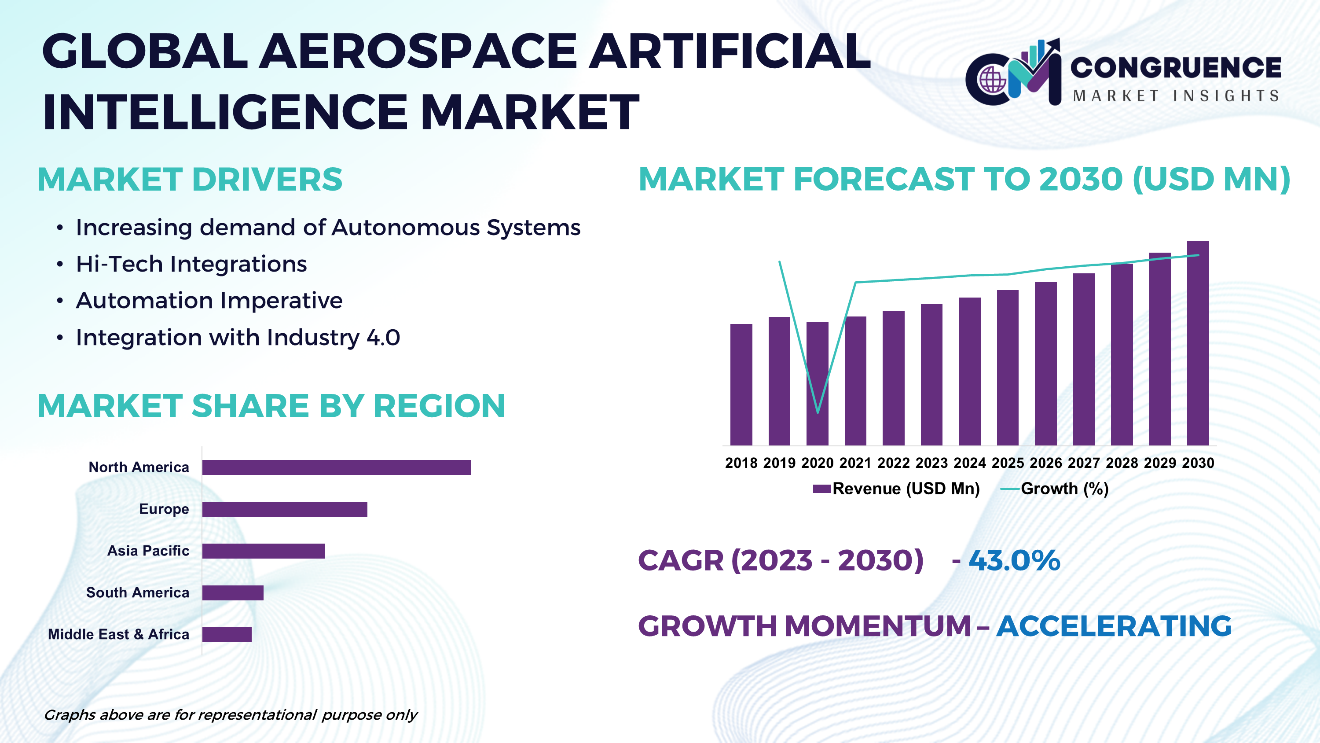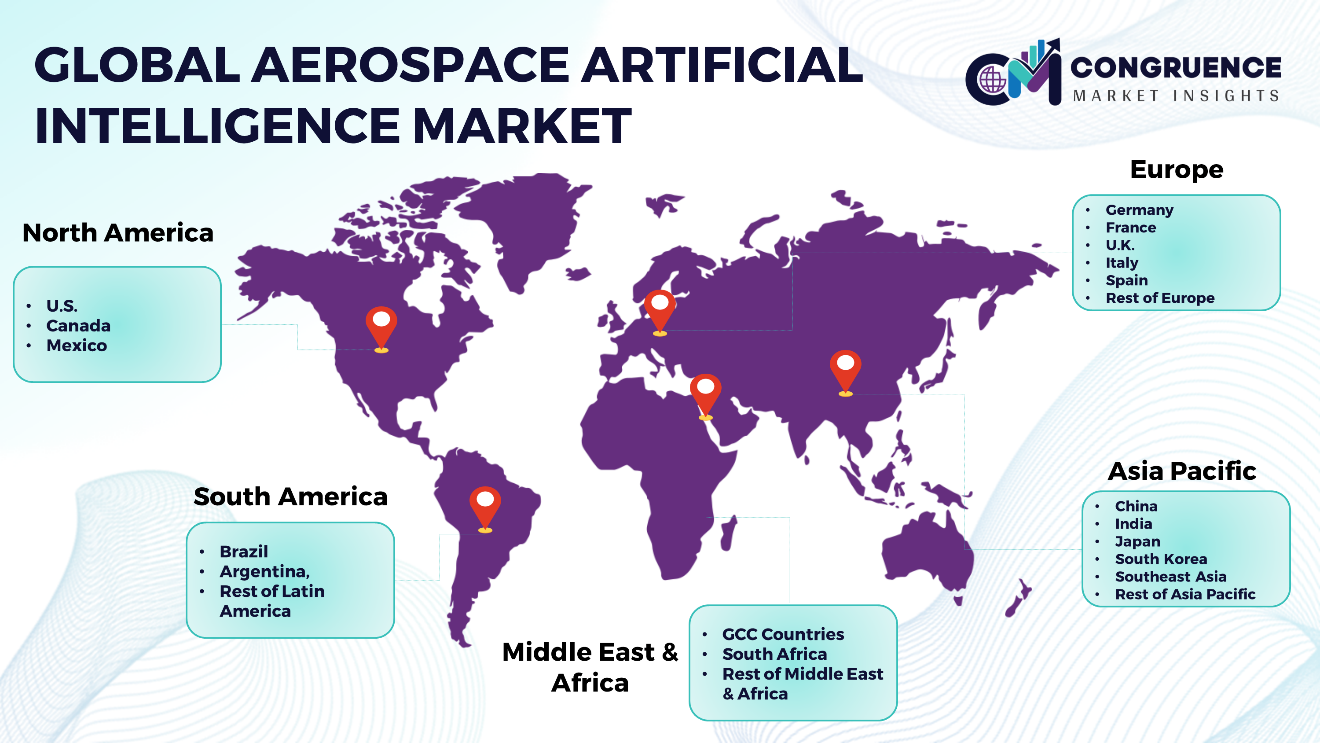Reports
The Global Aerospace Artificial Intelligence Market is expected to expand at a CAGR of 43.0% between 2023 and 2030. The global aerospace artificial intelligence market is experiencing notable expansion propelled by technological advancements and the growing incorporation of AI within aerospace applications. Integral constituents of this market encompass AI algorithms, machine learning systems, and robotics, pivotal in transforming various facets of the aerospace industry. The amalgamation of 5G and robotics augments communication, navigation, and automation, facilitating streamlined operations and heightened safety protocols. Furthermore, the fusion of AI with Industry 4.0 principles optimizes manufacturing processes and maintenance endeavors. The market landscape is characterized by prominent entities harnessing AI to elevate aircraft performance, safety standards, and operational efficacy.

Aerospace Artificial Intelligence Market Major Driving Forces
Increasing demand of Autonomous Systems: There is a rising demand within the aerospace industry for autonomous systems capable of functioning with minimal human intervention, particularly evident in military and defense sectors, as well as surveillance and reconnaissance operations.
Hi-Tech Integrations: Ongoing progress in artificial intelligence (AI) technologies, spanning machine learning, natural language processing, and computer vision, serves as a pivotal catalyst for transformative developments within the aerospace sector.
Automation Imperative: Increasing demands for automation across aircraft systems, encompassing autopilot systems, autonomous drones, and unmanned aerial vehicles (UAVs), are fostering the uptake of AI solutions in aerospace applications.
Integration with Industry 4.0: The integration of AI with Industry 4.0 principles, embracing concepts like smart manufacturing, digital twins, and cyber-physical systems, is driving efficiency improvements and cost optimization across the aerospace value chain.
Aerospace Artificial Intelligence Market Key Opportunities
Enhanced Aircraft Performance: AI algorithms can optimize aircraft performance by analyzing vast amounts of data in real-time, leading to improved fuel efficiency, reduced emissions, and enhanced operational capabilities.
Air Traffic Management: AI-based air traffic management systems can optimize flight routes, reduce congestion, and enhance airspace capacity, leading to more efficient and sustainable air transportation.
Predictive Maintenance: AI-powered predictive maintenance systems can identify potential equipment failures before they occur, reducing downtime, minimizing maintenance costs, and enhancing aircraft safety.
Aerospace Artificial Intelligence Market Key Trends
· Advancements in autonomous systems are revolutionizing UAVs, drones, and space exploration.
· Predictive maintenance solutions are reducing downtime and maintenance costs through proactive equipment failure prevention.
· Cockpit automation is enhancing flight safety and efficiency by automating navigation and decision support.
· AI-driven data analytics optimize flight operations and decision-making processes by extracting actionable insights from operational data.
· Smart manufacturing techniques improve efficiency, quality control, and cost-effectiveness in aerospace manufacturing.
· AI is pivotal in advancing space exploration through autonomous spacecraft navigation and data analysis.
· Personalization technologies enhance the passenger experience by tailoring in-flight services to individual preferences.
· AI-powered cybersecurity solutions protect aerospace systems from cyber threats and vulnerabilities.

Market Competition Landscape
The market competition landscape in the aerospace artificial intelligence sector is characterized by intense rivalry among industry players, driving innovation and technological advancements. Companies vie for market share through product differentiation, cost leadership, and strategic collaborations, striving to meet the evolving needs of the aerospace industry and gain a competitive edge.
Key players in the global Aerospace Artificial Intelligence market implement various organic and inorganic strategies to strengthen and improve their market positioning. Prominent players in the market include:
· Shield AI
· AIRBUS
· Lockheed Martin Corporation
· Northrop Grumman
· RTX
· General Dynamics Mission Systems, Inc.
· Thales Group
· BAE Systems
· Honeywell International Inc.
· Safran Group
· Leonardo S.p.A.
· General Electric
· L3Harris Technologies, Inc.
· Kratos Defense & Security Solutions, Inc.
· Textron Inc.
· SNC Corporation
· Elbit Systems Ltd.
|
Report Attribute/Metric |
Details |
|
Base Year |
2022 |
|
Forecast Period |
2023 – 2030 |
|
Historical Data |
2018 to 2022 |
|
Forecast Unit |
Value (US$ Mn) |
|
Key Report Deliverable |
Revenue Forecast, Growth Trends, Market Dynamics, Segmental Overview, Regional and Country-wise Analysis, Competition Landscape |
|
Segments Covered |
· By Offering (Hardware, Software, and Service) · By Technology (Machine Learning, Natural Language Processing, Computer Vision, Deep Learning, and Others) · By Application (Autonomous Systems, Training & Simulation, Flight Operations, Aircraft Maintenance, Surveillance & Security, and Others) · By End-User (Military and Defense, and Civil Aviation) |
|
Geographies Covered |
North America: U.S., Canada and Mexico Europe: Germany, France, U.K., Italy, Spain, and Rest of Europe Asia Pacific: China, India, Japan, South Korea, Southeast Asia, and Rest of Asia Pacific South America: Brazil, Argentina, and Rest of Latin America Middle East & Africa: GCC Countries, South Africa, and Rest of Middle East & Africa |
|
Key Players Analyzed |
Shield AI, AIRBUS, Lockheed Martin Corporation, Northrop Grumman, RTX, General Dynamics Mission Systems, Inc., Thales Group, BAE Systems, Honeywell International Inc., Safran Group, Leonardo S.p.A., General Electric, L3Harris Technologies, Inc., Kratos Defense & Security Solutions, Inc., Textron Inc., SNC Corporation, Elbit Systems Ltd. |
|
Customization & Pricing |
Available on Request (10% Customization is Free) |
